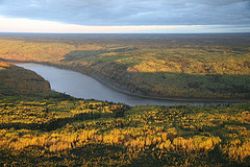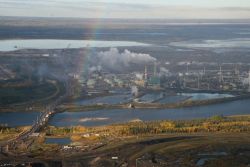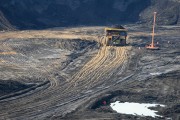When it rains, it pours.
In the weeks before Christmas, I had big plans to hunker down and finish writing a report, before heading off to visit family — but December brought a flurry of oilsands news, most of it centred around water monitoring in the oilsands, a subject Pembina has followed closely for several years.
First came the report by federal Environment Commissioner Scott Vaughn, who noted the federal government is failing to adequately monitor and report on Canada's fresh water. Then came the release of the Royal Society of Canada's report that echoed our concerns about water monitoring in the oilsands and, just when I thought I could turn my thoughts to eggnog and stockings, came announcements from the provincial and federal governments stating the need to overhaul the monitoring systems in question.
Why the sudden focus on water monitoring in the oilsands? If you take a closer look, you'll see this topic was actually building during the last few years. Concerns were mounting about deformed fish, health concerns downstream and seeping tailings ponds. More independent science was emerging, pointing to pollution impacts from oilsands development in the Athabasca River.
 When push came to shove, the current monitoring systems, such as the Regional Aquatic Monitoring Program (RAMP), could not dispel any of these concerns. The good news is the federal government is now acting swiftly and has given senior officials 90 days to design a monitoring system in conjunction with the provincial government that incorporates the long list of recommendations from the December reports.
When push came to shove, the current monitoring systems, such as the Regional Aquatic Monitoring Program (RAMP), could not dispel any of these concerns. The good news is the federal government is now acting swiftly and has given senior officials 90 days to design a monitoring system in conjunction with the provincial government that incorporates the long list of recommendations from the December reports.
So, what should water monitoring accomplish and why is it so important? The first step is to establish the starting point, or the baseline conditions, so the impacts of future development can be compared to pre-development data. Unfortunately, it's 40 years too late to measure pre-development conditions in the oilsands.
As the Royal Society's report acknowledges, our understanding of the impact oilsands development is having on freshwater supplies is lacking. Right now, Environment Canada has just one long-term water quality monitoring station on the Athabasca River, which is not capable of monitoring oilsands pollutants. And the Regional Aquatics Monitoring Program is not a shining star either. The Royal Society's report called for several improvements to the RAMP program, including more frequent scientific reviews, increased transparency and verifiable results.
A few tweaks to a fundamentally flawed monitoring program is not the answer though. We need a completely new approach to monitoring, one that is at arms length from industry, that has much more to offer in the way of scientific rigour, that measures impacts upstream and downstream of large industrial projects on the Athabasca River and which is completely transparent to members of the public in how it collects and analyzes the data it collects.
 What we can do is start collecting information frequently, as soon as possible. Over time, we'll be able to establish long-term trends. This means problems can be detected early and environmental concerns can be dealt with proactively, as opposed to reactively. Credible monitoring also allows regulators to set enforceable laws, relying on factual information that multiple parties can agree on for decision-making processes.
What we can do is start collecting information frequently, as soon as possible. Over time, we'll be able to establish long-term trends. This means problems can be detected early and environmental concerns can be dealt with proactively, as opposed to reactively. Credible monitoring also allows regulators to set enforceable laws, relying on factual information that multiple parties can agree on for decision-making processes.
Without an adequate monitoring system, it's hard to know what we are trying to enforce with regards to specific standards on the Athabasca River. That's why, until there's been a serious overhaul of the water monitoring system, we shouldn't be continuing to expand oilsands development. Approvals for new mining projects are currently in the works, even though we are unable to adequately monitor the current impacts of development.
Water issues aren't something you want to ignore — after all, water is a necessity of life, and it fuels the majority of economic and industrial activities across the country. The water impacts of oilsands development go far beyond just withdrawing large amounts of freshwater. Much of the freshwater used for oilsands processes becomes contaminated in the process and must therefore be collected in toxic tailings lakes. The Royal Society raised several questions about groundwater contamination and tailings pond seepage, as we at Pembina have been doing for years.
While the Royal Society concludes that current evidence suggests limited impact of oilsands development on aquatic ecosystem health, the report consistently refers to the severe lack of reliable data and limited understanding of the aquatic ecosystem, such as the complex relationship between groundwater and surface water.
We're pleased to see the provincial and federal governments working together to implement adequate new monitoring system, but the real question lies in what we plan to do with the data we collect. Will limits be set and will laws be enforced? And ultimately, if the data points to unacceptable changes in the Athabasca River, what are the federal and provincial governments prepared to do?









